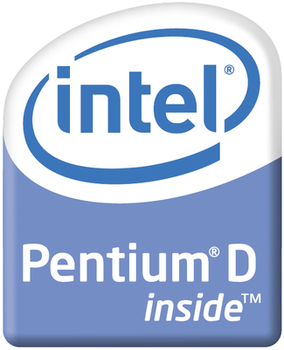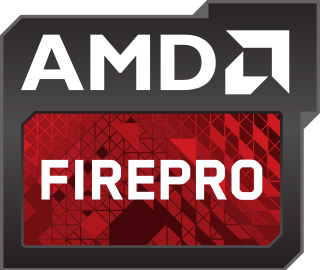
Advanced Micro Devices, Inc. (AMD) is an American multinational corporation and fabless semiconductor company based in Santa Clara, California, that designs, develops and sells computer processors and related technologies for business and consumer markets.

ATI Technologies Inc., commonly called ATI, was a Canadian semiconductor technology corporation based in Markham, Ontario, that specialized in the development of graphics processing units and chipsets. Founded in 1985, the company listed publicly in 1993 and was acquired by AMD in 2006. As a major fabrication-less or fabless semiconductor company, ATI conducted research and development in-house and outsourced the manufacturing and assembly of its products. With the decline and eventual bankruptcy of 3dfx in 2000, ATI and its chief rival Nvidia emerged as the two dominant players in the graphics processors industry, eventually forcing other manufacturers into niche roles.

A graphics processing unit (GPU) is a specialized electronic circuit initially designed to accelerate computer graphics and image processing. After their initial design, GPUs were found to be useful for non-graphic calculations involving embarrassingly parallel problems due to their parallel structure. Other non-graphical uses include the training of neural networks and cryptocurrency mining.

Dell XPS is a line of consumer-oriented laptop and desktop computers manufactured by Dell since 1993.

Pentium D is a range of desktop 64-bit x86-64 processors based on the NetBurst microarchitecture, which is the dual-core variant of the Pentium 4 manufactured by Intel. Each CPU comprised two cores. The brand's first processor, codenamed Smithfield and manufactured on the 90 nm process, was released on May 25, 2005, followed by the 65 nm Presler nine months later. The core implementation on the 90 nm Smithfield and later 65 nm Presler are designed differently but are functionally the same. The 90 nm Smithfield contains a single die, with two adjoined but functionally separate CPU cores cut from the same wafer. The later 65 nm Presler utilized a multi-chip module package, where two discrete dies each containing a single core reside on the CPU substrate. Neither the 90 nm Smithfield nor the 65 nm Presler were capable of direct core to core communication, relying instead on the northbridge link to send information between the two cores.

The nForce3 chipset was created by Nvidia as a Media and Communications Processor. Specifically, it was designed for use with the Athlon 64 processor.
The 65 nm process is an advanced lithographic node used in volume CMOS (MOSFET) semiconductor fabrication. Printed linewidths can reach as low as 25 nm on a nominally 65 nm process, while the pitch between two lines may be greater than 130 nm.

AMD FirePro was AMD's brand of graphics cards designed for use in workstations and servers running professional Computer-aided design (CAD), Computer-generated imagery (CGI), Digital content creation (DCC), and High-performance computing/GPGPU applications. The GPU chips on FirePro-branded graphics cards are identical to the ones used on Radeon-branded graphics cards. The end products differentiate substantially by the provided graphics device drivers and through the available professional support for the software. The product line is split into two categories: "W" workstation series focusing on workstation and primarily focusing on graphics and display, and "S" server series focused on virtualization and GPGPU/High-performance computing.
The AMD mobile platform is an open platform for laptops from AMD. Though little marketing was done on this platform, it has been competing with the Centrino platform in the segment to gain more marketshare. Each platform has its own specification, catching up the latest technology developments. Since the acquisition of ATI, AMD began to include Mobility Radeon GPUs and AMD chipsets as part of the requirements of the mobile platform; the first of such platforms is the Puma platform.
The Xpress 3200 is a revision of the Xpress 200 computer chipset released by ATI. The chipset supports AMD64 processors for Socket 939 and Socket AM2.
The AMD Quad FX platform is an AMD platform targeted at enthusiasts which allows users to plug two Socket F Athlon 64 FX or 2-way Opteron processors (CPUs) into a single motherboard for a total of four physical cores. This is a type of dual processor setup, where two CPUs are installed on a motherboard to increase computing power. The major difference between the platform and past dual processor systems like Xeon is that each processor has its own dedicated memory stores. The Quad FX platform also has HyperTransport capability targeted toward consumer platforms.
The AMD 700 chipset series is a set of chipsets designed by ATI for AMD Phenom processors to be sold under the AMD brand. Several members were launched in the end of 2007 and the first half of 2008, others launched throughout the rest of 2008.
The AMD 690 chipset series is an integrated graphics chipset family which was developed and manufactured by AMD subsidiary ATI for both AMD and Intel platforms focusing on both desktop and mobile computing markets. The corresponding chipset for the Intel platform has a marketing name of Radeon Xpress 1200 series.

Dell Vostro is a line of business-oriented laptop and desktop computers manufactured by Dell aimed at small to medium range businesses. From 2013–2015, the line was temporarily discontinued on some Dell websites but continued to be offered in other markets, such as Malaysia and India.
AMD FireStream was AMD's brand name for their Radeon-based product line targeting stream processing and/or GPGPU in supercomputers. Originally developed by ATI Technologies around the Radeon X1900 XTX in 2006, the product line was previously branded as both ATI FireSTREAM and AMD Stream Processor. The AMD FireStream can also be used as a floating-point co-processor for offloading CPU calculations, which is part of the Torrenza initiative. The FireStream line has been discontinued since 2012, when GPGPU workloads were entirely folded into the AMD FirePro line.
Michael Magee is a British journalist. He is credited with introducing a tabloid-style approach to the coverage of technology news. In 2009 the Daily Telegraph placed Magee 35 in its list of Top 50 most influential Britons in technology.
The nForce 700 is a chipset series designed by Nvidia first released in December 2007. The series supports both Intel Core 2 and AMD Phenom processors, and replaces the nForce 600 series chipsets. Several members were spotted, including the codenamed MCP72 for AMD processors and the C72 for Intel processors, launched with the name "nForce 780a" and "nForce 780i" chipsets respectively. Currently, the released variants are the 750i, 780i, 790i, and 790i Ultra.

On June 26, 2007, Dell released the new Inspiron desktop series, under the Dell Inspiron branding, as a replacement to the Dell Dimension desktop computers.









